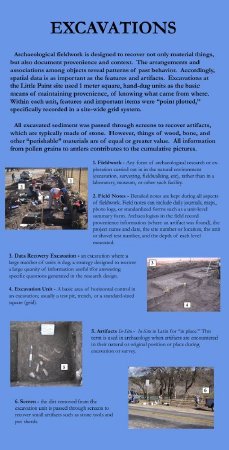Title:
Panel 3: Excavations
Collection:
Little Paint Collection
Object ID:
CAS.2013.07.PIC.84
VE Exhibit Label 1:
EXCAVATIONS
Archaeological fieldwork is designed to recover not only material things, but also document provenience and context. The arrangements and associations among objects reveal patterns of past behavior. Accordingly, spatial data is as important as the features and artifacts. Excavations at the Little Paint site used 1 meter square, hand—dug units as the basic means of maintaining provenience, of knowing what came from where. Within each unit, features and important items were "point plotted," specifically recorded in a site—wide grid system. All excavated sediment was passed through screens to recover artifacts, which are typically made of stone. However, things of wood, bone, and other "perishable" materials are of equal or greater value. All information from pollen grains to antlers contributes to the cumulative pictures.
Archaeological fieldwork is designed to recover not only material things, but also document provenience and context. The arrangements and associations among objects reveal patterns of past behavior. Accordingly, spatial data is as important as the features and artifacts. Excavations at the Little Paint site used 1 meter square, hand—dug units as the basic means of maintaining provenience, of knowing what came from where. Within each unit, features and important items were "point plotted," specifically recorded in a site—wide grid system. All excavated sediment was passed through screens to recover artifacts, which are typically made of stone. However, things of wood, bone, and other "perishable" materials are of equal or greater value. All information from pollen grains to antlers contributes to the cumulative pictures.
VE Exhibit Label 2:
1. Fieldwork— Any form of archaeological research or exploration carried out in the natural environment (excavating, surveying, fieldwalking, etc.) rather than in a laboratory, museum, or other such facility.
2. Field Notes— Detailed notes are kept during all aspects of feildwork. Field notes can include daily journals, maps, photo logs, or standardized forms such as a unit—level summary form. Archaeologists in the field record provenience information (where the artifact was found), the project name and date, the site number or location, the unit or shovel test number, and the depth of each level excavated.
2. Field Notes— Detailed notes are kept during all aspects of feildwork. Field notes can include daily journals, maps, photo logs, or standardized forms such as a unit—level summary form. Archaeologists in the field record provenience information (where the artifact was found), the project name and date, the site number or location, the unit or shovel test number, and the depth of each level excavated.
VE Exhibit Label 3:
3. Data Recovery Excavation— An excavation where a large number of units is dug; a strategy designed to recover a large quantity of information useful for answering specific questions generated in the research design.
4. Excavation Unit— A basic area of horizontal control in an excavation; usually a test pit, trench, or a standard—sized square (grid).
4. Excavation Unit— A basic area of horizontal control in an excavation; usually a test pit, trench, or a standard—sized square (grid).
VE Exhibit Label 4:
5. Artifacts In—Situ— In—Situ is Latin for "in place". This term is used in archaeology when artifacts are encountered in their natural or original position or place during an excavation or survey.
6.Screen— the dirt removed from the excavation unit is passed through screens to recover small artifacts such as stone tools and pot sherds.
6.Screen— the dirt removed from the excavation unit is passed through screens to recover small artifacts such as stone tools and pot sherds.
